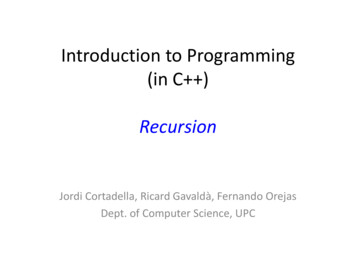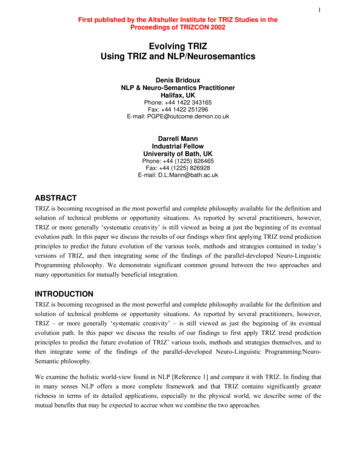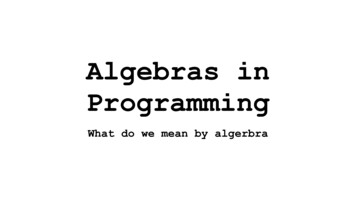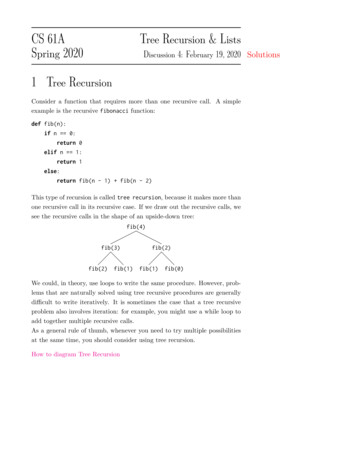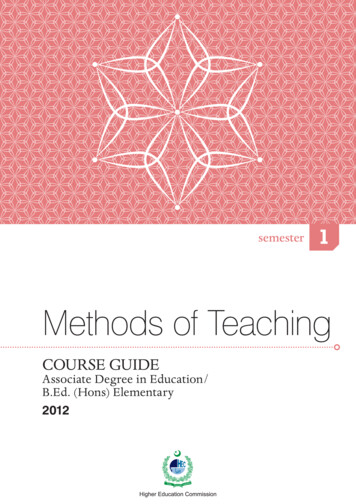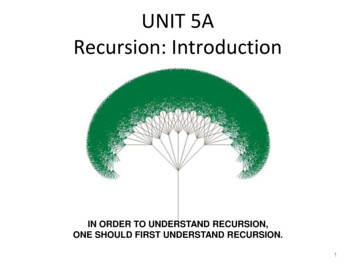
Transcription
UNIT 5ARecursion: IntroductionIN ORDER TO UNDERSTAND RECURSION,ONE SHOULD FIRST UNDERSTAND RECURSION.1
Announcements First written exam next week Wednesday All material from beginning is fair game– There are sample exams on the resources page2
Last time Iteration: repetition with variation Linear search Insertion sort A first look at time complexity (measure ofefficiency)3
This time Introduction to recursionWhat it isRecursion and the stackRecursion and iterationExamples of simple recursive functionsGeometric recursion: fractals4
RecursionThe Loopless Loop5
Recursion A recursive function is one that calls itself.def i am recursive(x) :maybe do some workif there is more work to do :i am recursive(next(x))return the desired result Infinite loop? Not necessarily, not if next(x)needs less work than x.3
Recursive DefinitionsEvery recursive function definition includes twoparts:– Base case(s) (non-recursive)One or more simple cases that can be doneright away– Recursive case(s)One or more cases that require solving“simpler” version(s) of the original problem. By “simpler”, we mean “smaller” or “shorter” or“closer to the base case”.4
Example: Factorial n! n (n-1) (n-2) 12! 2 13! 3 2 14! 4 3 2 1 alternatively:0! 1(Base case)n! n (n-1)!(Recursive case)So 4! 4 3! 3! 3 2! 2! 2 1! 1! 1 0!5
Recursion conceptually4! 4(3!)3! 3(2!)2! 2(1!)1! 1 (0!)Base casemake smaller instancesof the same problem6
Recursion conceptually4! 4(3!)3! 3(2!)2! 2(1!)1! 1 (0!) 1(1) 1Compute the base casemake smaller instancesof the same problem7
Recursion conceptually4! 4(3!)3! 3(2!)2! 2(1!) 21! 1 (0!) 1(1) 1Compute the base casemake smaller instancesof the same problembuild upthe result8
Recursion conceptually4! 4(3!)3! 3(2!) 62! 2(1!) 21! 1 (0!) 1(1) 1Compute the base casemake smaller instancesof the same problembuild upthe result9
Recursion conceptually4! 4(3!) 243! 3(2!) 62! 2(1!) 21! 1 (0!) 1(1) 1Compute the base casemake smaller instancesof the same problembuild upthe result10
Recursive Factorial in Python# 0! 1# n! n (n-1)!(Base case)(Recursive case)def factorial(n):if n 0: # base casereturn 1else:# recursive casereturn n * factorial(n-1)11
Inside Python RecursionSTACKn 4factorial(4)?15
Inside Python RecursionSTACKn 4factorial(4)? 4 * factorial(3)16
Inside Python RecursionSTACKn 4factorial(4)? 4 * factorial(3)n 3factorial(3)?17
Inside Python RecursionSTACKn 4factorial(4)? 4 * factorial(3)n 3factorial(3)? 3 * factorial(2)18
Inside Python RecursionSTACKn 4factorial(4)? 4 * factorial(3)n 3factorial(3)? 3 * factorial(2)n 2factorial(2)?19
Inside Python RecursionSTACKn 4factorial(4)? 4 * factorial(3)n 3factorial(3)? 3 * factorial(2)n 2factorial(2)? 2 * factorial(1)20
Inside Python RecursionSTACKn 4factorial(4)? 4 * factorial(3)n 3factorial(3)? 3 * factorial(2)n 2factorial(2)? 2 * factorial(1)n 1factorial(1)?21
Inside Python RecursionSTACKn 4factorial(4)? 4 * factorial(3)n 3factorial(3)? 3 * factorial(2)n 2factorial(2)? 2 * factorial(1)n 1factorial(1)? 1 * factorial(0)22
Inside Python RecursionSTACKn 4factorial(4)? 4 * factorial(3)n 3factorial(3)? 3 * factorial(2)n 2factorial(2)? 2 * factorial(1)n 1factorial(1)? 1 * factorial(0)n 0factorial(0) 123
Inside Python RecursionSTACKn 4factorial(4)? 4 * factorial(3)n 3factorial(3)? 3 * factorial(2)n 2factorial(2)? 2 * factorial(1)n 1factorial(1) 1 * 1 124
Inside Python RecursionSTACKn 4factorial(4)? 4 * factorial(3)n 3factorial(3)? 3 * factorial(2)n 2factorial(2) 2 * 1 225
Inside Python RecursionSTACKn 4factorial(4)? 4 * factorial(3)n 3factorial(3) 3 * 2 626
Inside Python RecursionSTACKn 4factorial(4) 4 * 6 2427
Recursive vs. Iterative Solutions For every recursive function,there is an equivalent iterative solution. For every iterative function,there is an equivalent recursive solution. But some problems are easier to solve oneway than the other way. And be aware that most recursive programsneed space for the stack, behind the scenes12
Factorial Function (Iterative)def factorial(n):result 1# initialize accumulator varfor i in range(1, n 1):result result * ireturn resultVersus (Recursive):def factorial(n):if n 0:# base casereturn 1else:# recursive casereturn n * factorial(n-1)13
A Strategy for Recursive ProblemSolving (hat tip to Dave Evans) Think of the smallest size of the problem andwrite down the solution (base case) Now assume you magically have a workingfunction to solve any size. How could you useit on a smaller size and use the answer tosolve a bigger size? (recursive case) Combine the base case and the recursive case14
Iteration to Recursion: exercise Mathematicians have provedπ2/6 1 1/4 1/9 1/16 .We can use this to approximate πCompute the sum, multiply by 6, take the square rootdef pi series iter(n) :result 0for i in range(1, n 1) :result result 1/(i**2)return resultdef pi approx iter(n) :x pi series iter(n)return (6*x)**(.5)Let's convert this to arecursive function(see file pi approx.pyfor a sample solution.)31
Recursion on Lists First we need a way of getting a smaller inputfrom a larger one:– Forming a sub-list of a list: a [1, 11, 111, 1111, 11111, 111111] a[1:][11, 111, 1111, 11111, 111111]the "tail" of list a a[2:][111, 1111, 11111, 111111] a[3:][1111, 11111, 111111] a[3:5][1111, 11111] 32
Recursive sum of a listdef sumlist(items):if items []:The smallest size list is theempty list.15
Recursive sum of a listdef sumlist(items):if items []:return 0Base case:The sum of an empty list is 0.15
Recursive sum of a listdef sumlist(items):if items []:return 0else:Recursive case:the list is not empty15
Recursive sum of a listdef sumlist(items):if items []:return 0else:.sumlist(items[1:]).What if we already know thesum of the list's tail?15
Recursive sum of a listdef sumlist(items):if items []:return 0else:return items[0] sumlist(items[1:])What if we already know thesum of the list's tail? We canjust add the list's first element!15
Tracing sumlistdef sumlist(items):if items []:return 0else:return items[0] sumlist(items[1:]) sumlist([2,5,7])sumlist([2,5,7]) 2 sumlist([5,7])5 sumlist([7])7 sumlist([])0After reaching the base case, the final result isbuilt up by the computer by adding 0 7 5 2.16
List Recursion: exercise Let's create a recursive function rev(items) Input: a list of items Output: another list, with all the same items,but in reverse order Remember: it's usually sensible to break thelist down into its head (first element) and itstail (all the rest). The tail is a smaller list, andso "closer" to the base case. Soooo (picture on next slide)39
Reversing a list: recursive caseSee file rev list.py40
Multiple Recursive Calls So far we've used just one recursive call tobuild up our answer The real conceptual power of recursionhappens when we need more than one! Example: Fibonacci numbers41
Fibonacci Numbers A sequence of numbers:0 1 1 2 3 5 813.17
Fibonacci Numbers in Nature 0, 1, 1, 2, 3, 5, 8, 13, 21, 34, 55, 89, 144, 233, etc.Number of branches on a tree, petals on a flower,spirals on a pineapple.Vi Hart's video on Fibonacci numbers(http://www.youtube.com/watch?v ahXIMUkSXX0)18
Recursive DefinitionLet fib(n) the nth Fibonacci number, n 0–fib(0) 0(base case)–fib(1) 1(base case)–fib(n) fib(n-1) fib(n-2),n 1def fib(n):if n 0 or n 1:return nTwo recursive calls!else:return fib(n-1) fib(n-2)20
Recursive Call )1fib(0)0fib(0) 0fib(1) 1fib(n) fib(n-1) fib(n-2), n 122
Iterative Fibonaccidef fib(n):x 0next x 1for i in range(1,n 1):x, next x next x, x next xreturn xsimultaneousassignmentFaster than therecursive version.Why?23
Geometric Recursion (Fractals) A recursive operation performed onsuccessively smaller et/recursion.jpg24
Sierpinski’s Triangle25
Sierpinski’s Carpet26
(the next slide shows an animationthat could give some peopleheadaches)50
Mandelbrot setSource: Clint Sprott, 1
Fancier fractals52
Now,BinarySearchrecursion forsearchimage: Matt Roberts, http://people.bath.ac.uk/mir20/blogposts/bst close up.php32
Introduction to recursion What it is Recursion and the stack Recursion and iteration Examples of simple recursive functions Geometric recursion: fractals 4 . 5 Recursion The Loopless Loop . Recursion A recursive function is one that calls itself.
